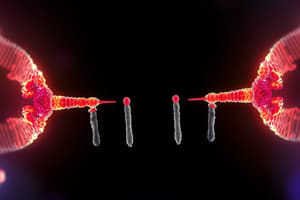Podcast
Questions and Answers
What is the primary purpose of Meiosis I in cell division?
What is the primary purpose of Meiosis I in cell division?
- To separate sister chromatids
- To duplicate the genetic material
- To reduce the chromosome number from diploid to haploid (correct)
- To produce identical daughter cells
Which stage of Meiosis I is characterized by the pairing of homologous chromosomes?
Which stage of Meiosis I is characterized by the pairing of homologous chromosomes?
- Telophase I
- Prophase I (correct)
- Metaphase I
- Anaphase I
During which phase of Prophase I does crossing over occur?
During which phase of Prophase I does crossing over occur?
- Pachytene (correct)
- Zygotene
- Diakinesis
- Leptotene
What happens to the synaptonemal complex during Diplotene?
What happens to the synaptonemal complex during Diplotene?
What is formed during the Zygotene phase of Meiosis I?
What is formed during the Zygotene phase of Meiosis I?
What is the main significance of independent assortment during Metaphase I?
What is the main significance of independent assortment during Metaphase I?
What occurs during Anaphase I that is different from mitosis?
What occurs during Anaphase I that is different from mitosis?
What happens at Telophase I after the chromosomes reach the opposite poles?
What happens at Telophase I after the chromosomes reach the opposite poles?
How many haploid daughter cells are formed at the end of Meiosis I?
How many haploid daughter cells are formed at the end of Meiosis I?
Which process typically follows Telophase I to complete the division of the cell?
Which process typically follows Telophase I to complete the division of the cell?
Flashcards are hidden until you start studying
Study Notes
Overview of Meiosis I
- Meiosis I is a reductional division that decreases chromosome number from diploid (2n) to haploid (n).
- Homologous chromosomes are separated into different cells, generating four genetically distinct daughter cells from one parental cell.
- Essential for sexual reproduction in all sexually reproducing organisms, including animals, plants, and fungi.
- Comprises stages: Prophase I, Metaphase I, Anaphase I, and Telophase I.
Prophase I
- Longest and most complex phase, further divided into five stages: Leptotene, Zygotene, Pachytene, Diplotene, and Diakinesis.
- Leptotene: Chromosomes condense and become visible. Each chromosome consists of two sister chromatids.
- Zygotene: Homologous chromosomes pair through synapsis, forming tetrads (bivalents) with four chromatids.
- Pachytene: Crossing over occurs; homologous chromosomes exchange genetic material at chiasmata, increasing genetic diversity.
- Diplotene: Synaptonemal complex breaks down; homologous chromosomes begin to separate but remain linked at chiasmata.
- Diakinesis: Chromosomes condense further, nuclear envelope disintegrates, spindle apparatus forms, and kinetochores attach to spindle fibers.
Metaphase I
- Tetrads align at the metaphase plate in the center of the cell.
- Orientation of tetrads is random, facilitating independent assortment and contributing to genetic variability.
- Spindle fibers attach to kinetochores of homologous chromosomes from opposite cell poles.
Anaphase I
- Homologous chromosomes are pulled apart to opposite poles by spindle fibers.
- Sister chromatids remain attached at centromeres and do not separate during this phase.
- Ensures each daughter cell receives a haploid set of chromosomes.
Telophase I
- Chromosomes reach opposite poles, and the nuclear membrane may reform around each chromosome set.
- Chromosomes may slightly de-condense but may remain condensed in some species.
- Followed by cytokinesis, which divides the cytoplasm and forms two haploid daughter cells.
Cytokinesis
- Accompanies Telophase I, resulting in two haploid cells.
- Each daughter cell contains half the original chromosome number, but each chromosome still has two sister chromatids.
Outcome of Meiosis I
- Produces two non-identical haploid daughter cells, each containing half the number of chromosomes as the original diploid cell.
- These haploid cells proceed to Meiosis II, leading to the formation of four genetically distinct haploid gametes.
Significance of Meiosis I
- Critical for sexual reproduction, ensuring the chromosome number is halved.
- Guarantees that upon fertilization, the resulting offspring have the correct diploid chromosome number.
Studying That Suits You
Use AI to generate personalized quizzes and flashcards to suit your learning preferences.




